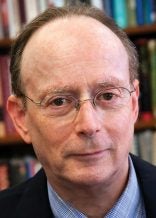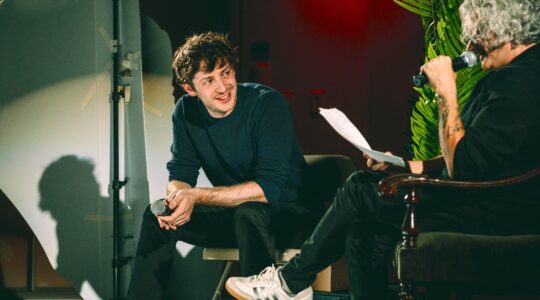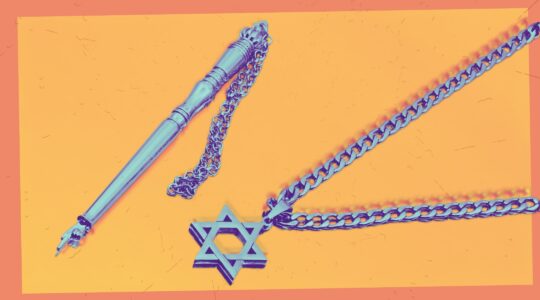Micah Goodman, 39, a rising star in Israel as a philosopher, author, television personality and catalyst for change, makes a strong case that the deep divide between religious and secular Jews in Israel is narrowing.
He points to the fact that Jewish texts and values have made their way in recent years into Israeli mainstream culture, including feature films, prime-time television shows, popular music and books. Case in point: Two of his books, one on the writings of Maimonides and the other on the “Kuzari,” the famous work by the Spanish philosopher-poet Rabbi Yehuda HaLevi, were best sellers in Israel despite dealing with ancient Jewish history.
“This could not have happened 10 years ago,” he says.
And most significantly, based on an experimental leadership program he directs in the Judean Hills for post-army, pre-university young men and women, Goodman asserts that Israelis in their 20s are showing increasing interest in their Jewish heritage and traditions. Not, he emphasizes, out of a desire to become more observant religiously, but rather to explore and understand how and where Judaism can fit into their secular lives.
“It’s not about the secular becoming religious,” he says. “It’s about Israelis becoming Jewish.” His goal is to deepen their “Israeliness.”
During a recent visit Goodman made to New York, I spent enough time with him — during a lecture, a long lunch and then an interview — to be convinced that he has his pulse on the current Israeli zeitgeist, with its hopeful signs of a Jewish renaissance.
“Israel is changing,” he told his audience at the outset of a lecture in Teaneck, N.J. “For the past 15 years something has been happening under the radar,” a renewed interest in things Jewish, which now is gaining traction and attention.
He then launched into a lengthy explanation of why that is so, going back to the historical and philosophical underpinnings of Zionist ideology. He focused on the tensions between the writings of Micah Joseph Berdichevsky (1865-1921) and Ahad Ha’am (the pen name for Asher Zvi Hirsch Ginsberg, 1856-1927), two Russian-born thinkers from chasidic families who wrote of the tensions between Jewish tradition and assimilation.
That may sound academic, even boring. But Goodman was dynamic, engaging and often humorous as he moved around the room, speaking with no notes, sprinkling his points with personal anecdotes and observations.
He described Berdichevsky as a key figure among those early Zionist thinkers whose attitudes towards their fellow Jews had a twinge of anti-Semitism.
The notion of the “ugly Jew,” someone “impossible not to despise,” also ran through the writings of founding fathers like Zeev Jabotinsky and Theodor Herzl; they believed that Zionism was the answer to anti-Semitism, Goodman said.
“These early Zionists saw Judaism as an environmental disease,” he noted. Their approach was part political, part therapeutic as they sought to expunge Judaism in creating The New Jew — strong, bold, and a reaction to the long-held fear of non-Jews and of religious authority. The result was a Zionism that “cured” the Jews by rejecting Judaism.
“They wanted to create a state and a kind of Jew that didn’t exist, liberating the Jew from his past and his fear of goyim and of God,” according to Goodman.
By contrast, Ahad Ha’am sought to incorporate the ethical and cultural values of Judaism into the Zionist state. In his work he called for “a Jewish state and not merely a state of Jews,” and, though secular, he envisioned Israel as a spiritual center for Jews, where Jewish texts like the Bible would be a source of inspiration.
In the end, Ahad Ha’am’s vision lost to Berdichevsky’s, Goodman said, and sadly, “we paid a terrible price because secularism turned into ignorance [of Judaism]” in Israeli society, and many of Israel’s citizens have “an allergic reaction to tradition.”
Part of the ripple effect was that Israelis became disconnected from the Jewish traditions that diaspora Jews shared.
Thriving In The Desert
‘Now we can better understand Israel today,” Goodman said as he turned to the present-day phenomenon that finds young secular Jews studying Talmud and other traditional texts and attending Friday evening services outdoors in Tel Aviv. Perhaps this renewed interest in tradition is best exemplified by innovative educators like Ruth Calderon, whose inspiring maiden speech as a Knesset member last year, asserting that Jewish texts are for all Jews, went viral and captured the imagination of many.
While Calderon came to Talmud study from a secular background, Goodman had the opposite experience: he grew up observant, and studied at a traditional yeshiva. He launched his leadership program, Ein Prat, in 2006, and its most popular element is a four-month, 24/7 course at a remote spot in the Judean Hills. There the young men and women — who find themselves in that uniquely Israeli limbo between completion of the army and beginning university — study Bible, Talmud, secular philosophy and literature, with a large dose of yoga and other physical exercise thrown in the mix.
Six people were in the initial group; seven the next year. But the program grew by word of mouth, and now there are more than 350 participants; about 70 percent of them are secular and 30 percent observant. What’s more, they pay to attend and live in an old trailer camp, start their long days at 6:30 a.m. and get no university credit. Why do they do it?
I visited Ein Prat for a day last year (“Narrowing The Secular-Religious Gap In Israel,” June 14, 2013) to see for myself, and came away impressed with the students and faculty, and with a program that combined the passion of traditional study halls and the rigor of university inquiry and debate.
One young Sephardic woman from Rishon L’Zion told me, “I came to learn who I am and where I come from, and because I want my children to know where they come from.”
Goodman observes that secular graduates say they came to Ein Prat and “got connected.” The observant ones say they came and “opened up.”
In a presentation he made while in New York to members of the Jewish Funders Network, he described the growth and reach of the Jewish Renewal movement in Israel — a loose collection of programs offering learning opportunities for Israelis. The programs touch on Jewish identity, text, prayer, spirituality and/or social action, all anchored in the principles of pluralism and autonomy. Ein Prat is a prime example.
(JFN recently published a “Guide to Jewish Giving” on the subject of “Jewish Renewal In Israel.”)
Goodman observed that American Jewish philanthropists seem to appreciate the values and goals of the Renewal movement more readily than their Israeli counterparts. The Israelis, he said, find it hard to believe that the goal of the programs is not about making the participants more religious. By contrast, the Americans are more aligned with the movement, he said, because it reflects how Judaism is widely practiced here — primarily out of choice, with an emphasis on pluralistic values.
He’s hoping that increasing numbers of young Israelis, confident in their secular lifestyle, will think of Judaism as a source of inspiration to explore rather than of constrictive rules and obligations to avoid. He sees his work as “helping to empower this generation of Israelis to radiate” their openness and curiosity in creating a more balanced society, renewing rather than rejecting Jewish tradition.
The New York Jewish Week brings you the stories behind the headlines, keeping you connected to Jewish life in New York. Help sustain the reporting you trust by donating today.





